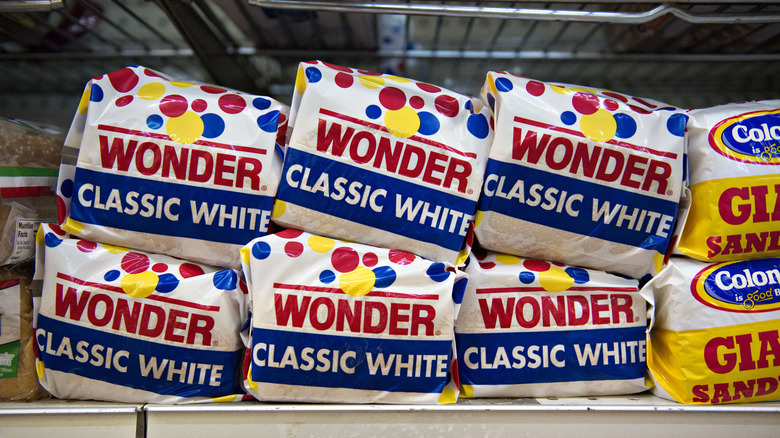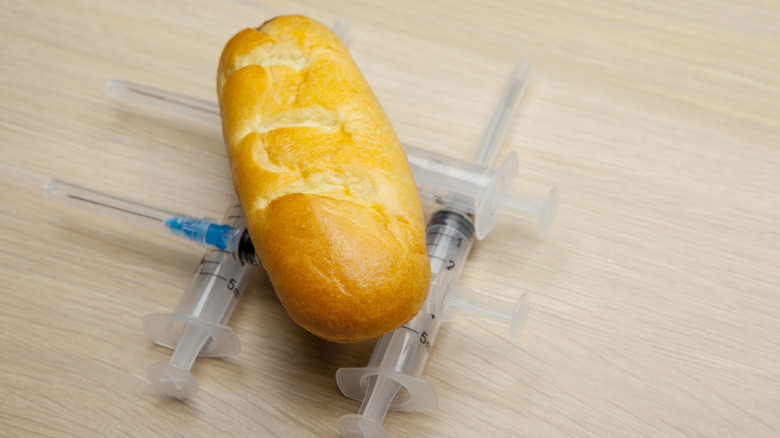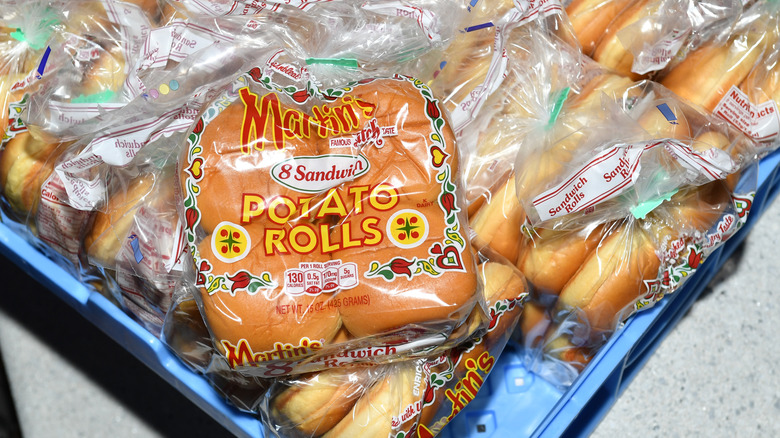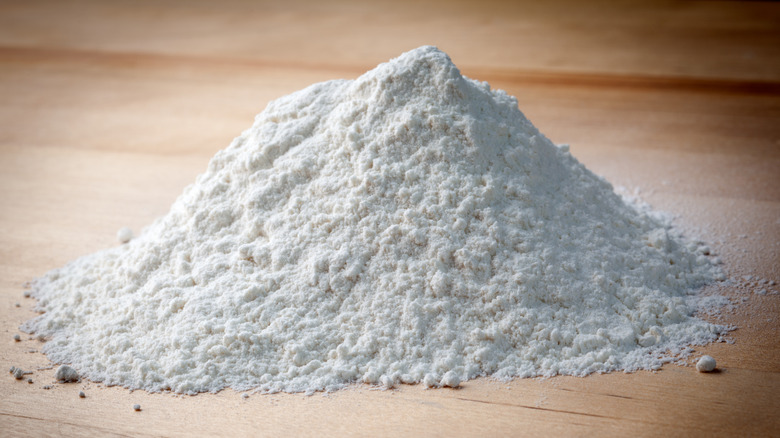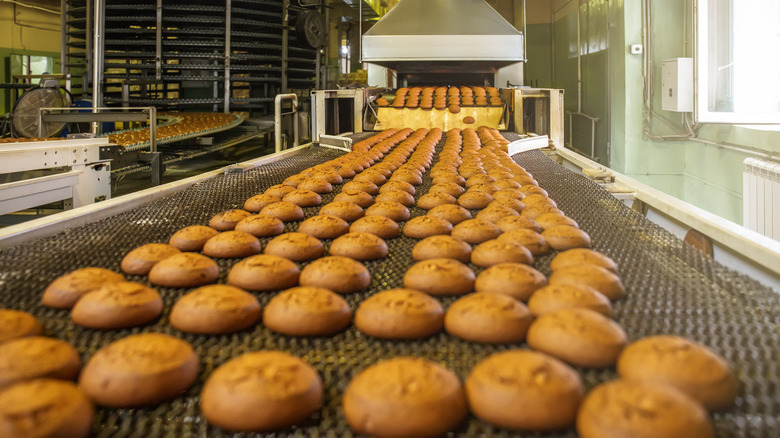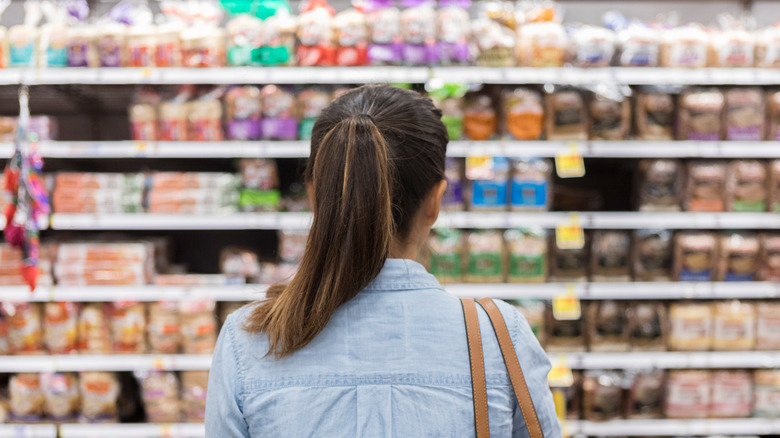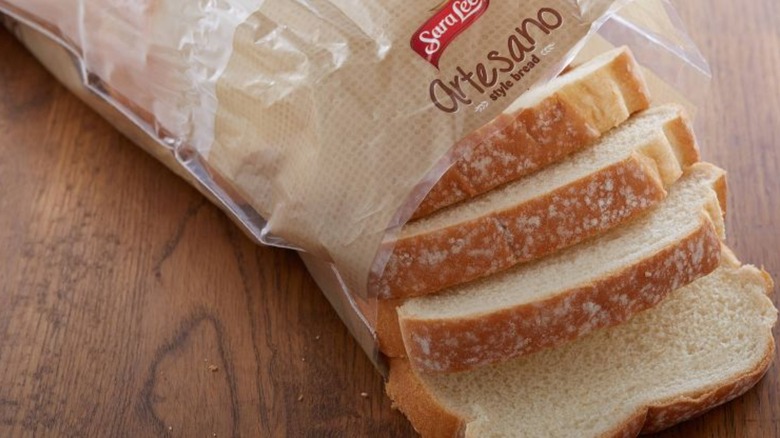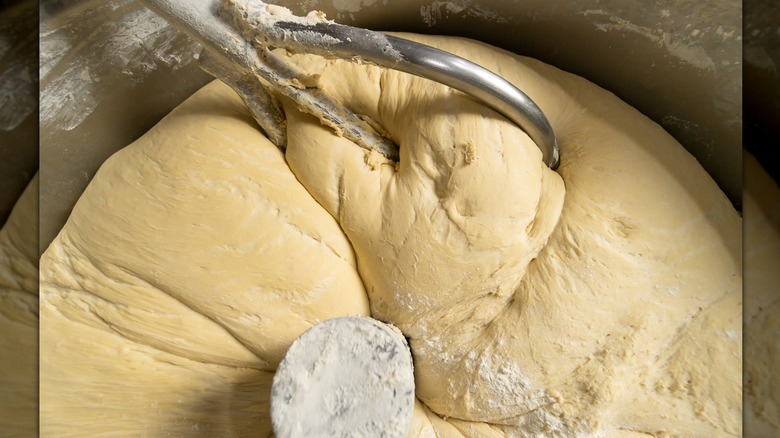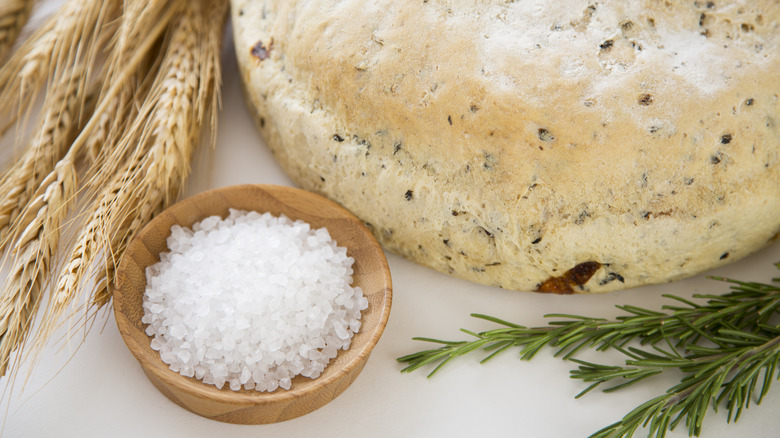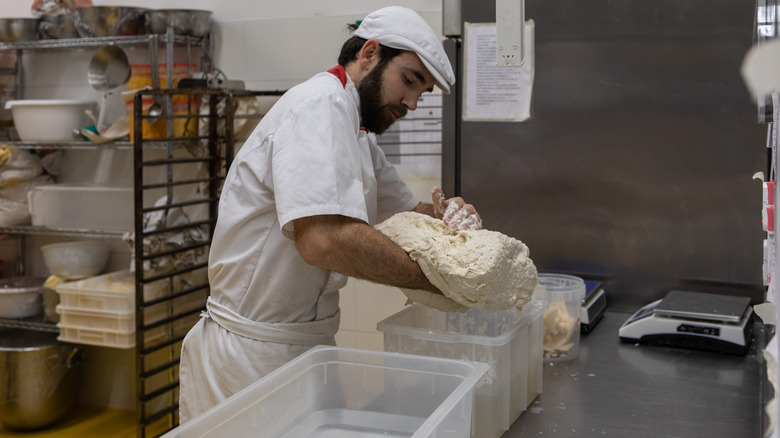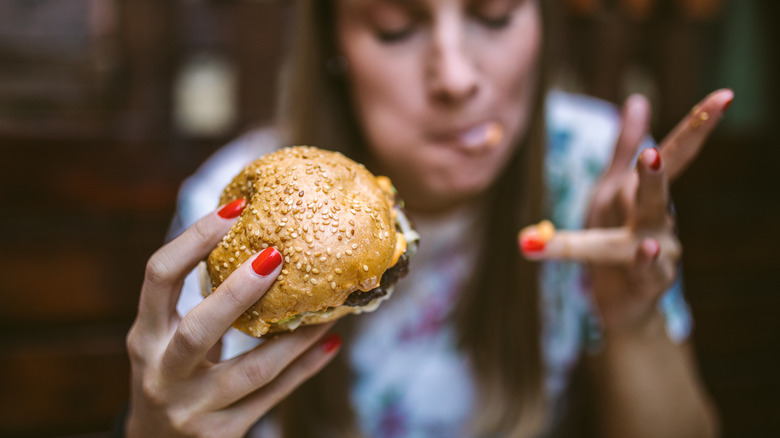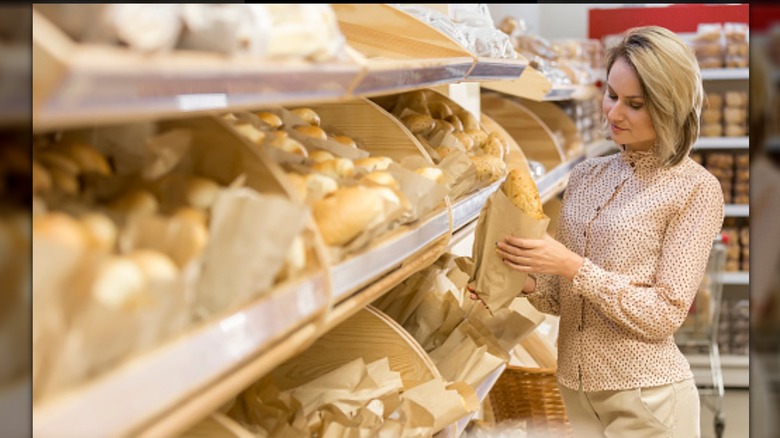All The Ways The US Completely Ruined Bread
Okay, we didn't completely ruin bread — did we? We'll leave that up for debate. One thing we know for sure is that the bread served in America can look very different from bread dished up in other countries, especially when it comes to ingredients. And though we certainly aren't the only country to offer pre-sliced snow white loaves to the public, we also may not have a full grasp of why our bread isn't as fresh and nutritious as it could be, much less the implications that eating too many of these fluffy white slices could have on our health down the road.
In this article, we'll detail how America has managed to effectively ruin one of the most cherished and versatile foods on the planet. We're taking a close-up look at ingredients often found in American bread, while also breaking down the factors that make the bread so different from what you might find in locations around the globe. Whether or not this will change your mind concerning your beloved plastic-encapsulated loaf, we're not sure. But knowledge is power, and with that, let's go ahead and slice into the details.
Using preservatives as additives
Preservatives in foods are common, but should we be okay with preservatives lurking in our bread? That's a good question. In reality, bread shouldn't need preservatives. It can naturally be made with wheat flour, yeast, water, and salt. It is these ingredients that are the only ingredients permitted in baguettes sold in France, according to "Le Décret Pain" law issued in 1993. But if preservatives aren't necessary in bread, why do we find them there?
Preservatives work to ensure that our food stays safe and shelf-stable. There are many preservative types, and each can be added at different stages of food making in order to ensure the product turns out — and stays — as desired. Though this is an arguably very necessary additive, it may have a negative effect on our health when consumed in excess. Worries exist over whether or not preservatives are potentially carcinogenic (via Environmental Working Group), and many out there are allergic to certain preservative types (via the Canadian Institute of Food Safety), making their use even more controversial.
Preservatives may prove helpful, but they aren't necessary when bread is freshly cooked and eaten promptly. This is the way that bread is often enjoyed, much like it is in the many boulangeries or bread shops commonly found in France. Nevertheless, the use of preservatives like calcium propionate continues to show up in bread ingredient lists here in the States, and we suppose that isn't going to change any time soon.
Added sugar
Sugar is often found in American bread, and to be honest, it isn't usually in high amounts. In a single slice of generic white bread, you might find 2 grams of sugar (or less), which may total 4 grams per two slices. Still, though this may be the case with many breads you pick up, don't expect it to be the case with all, especially your "specialty" types. Bread that comes in the form of "oat," "cinnamon," "potato," or the like will often deliver a surgary blow to your system, with some bread types, like Pepperidge Farm Homestyle Oat, delivering 8 grams of added sugar per two slices. High fructose corn syrup is another common bread offender, though it's a little less common to find this additive in bread these days.
Is this the norm in other countries? Not quite. One TikTok poster amassed a great deal of attention by sharing his opinion concerning Australian bread and why it tastes so salty compared to bread in America. Australians fired back their responses, many of which cited that American bread is loaded with sugar and is practically cake in their eyes. Not to mention, nowhere in the Le Décret Pain law mentioned earlier is sugar discussed. Thus, we can conclude that adding gobs of sugar and high fructose corn syrup isn't actually needed in order to achieve fresh, delicious-tasting bread.
Using bleached flour
Bleached flour may be advantageous in many ways, but ultimately, it is an unnecessarily processed grain. Unlike unbleached flour, bleached flour undergoes a process in which its bran and germ are removed. The remaining product is then bleached using chemical agents, but this isn't only for looks, as some may assume. The bleaching process actually helps expedite the aging process, which primes the bread in order to get it ready for baking.
So, what's wrong with this process? A lot, we're afraid. Aside from the concerning chemicals used in the bleaching process (i.e., potassium bromate, which is also banned in several countries), stripping the natural wheat grain of its germ and bran gets rid of nutrients that are vital to our health. Nutrients like protein, niacin, and folate are all examples of the goodness that could potentially benefit our bodies that get ousted in the name of faster-aging dough. Instead, we get chemically bleached flour lacking nutrients but still at least looks fluffy and white. All in all, buying bread that utilizes unbleached flour will be your best bet when selecting a bread loaf. Though it still won't be the same as freshly baked bread at home, it will at least provide you with nutrients you wouldn't otherwise get from your typical snow white, store-bought loaf.
Mass production
Like almost anything that is mass-produced, bread in America has taken a hit as it is no longer formed in small batches where attention to detail is a must. Instead, "bakers" of store-bought bread use machinery, additives, sugar, and the like to make bread that tastes good to the average American citizen. But is that how bread is supposed to be?
Take your average white bread slice, for example. It looks different from that warm, fluffy baguette you'd grab from your local bakery. The crumb on the processed bread is tightly packed, comes in a pre-sliced loaf, and loaded with unnecessary ingredients. We know that mass production makes it possible to satisfy the ongoing demand for bread, making it both convenient and possible for customers to grab from the store. But true artisan bread, such as those found in French boulangeries, undergoes proper fermentation as well as overall attention to detail that yields a completely different result.
Hey, we know you're hungry and may have a family to feed, and going to your local bakery to buy your bread every week truly may not be feasible. But for what it's worth, you should know that this American way of bread-buying isn't necessarily the best, and we'd argue, is a much lower quality flavor and texture experience to say the least.
Americans are used to the same ol' thing
Does your average grocery run usually include the purchase of fresh bread? Probably not. For most of us, the typically shelved white or wheat loaf is what makes it on our grocery list, and that is for no reason. While it technically may not be the only bread type sold in grocery stores, it certainly dominates the American market. Whether white, whole wheat, honey wheat, or oat, traditional "pan loaves" that come pre-sliced loaves in plastic packages are a far cry from the fresh bread we could pick up at our local bakery.
Though the American bread industry tends to supply markets with the typical white and wheat bread fare, some brands and varieties are better than others, especially in terms of ingredients. Watching for additives, excess sugar, preservatives, artificial colors, and more can help you sidestep bread options that may eventually wreak havoc on your health. Instead, opt for bread with minimal ingredients containing components you might find in your home pantry. Though still not as fresh, you'll at least consume bread that's better than some of the others available.
It's hardly ever fresh-baked when purchased in store
Almost any bread you find in the grocery store aisle is far from fresh-baked. Some bread types (like Sara Lee Artesano) may laughably attempt to give the illusion of steam by artistically "fogging up" the bag. In reality, those pre-sliced white loaves may have been baked a few days ago and probably contain enough preservatives to keep them hanging on for at least another week in your cabinet. In contrast, most fresh-baked bread will typically only last a few days at most.
We know what you're thinking. Your local grocery store actually does sell fresh bread, right? Possibly. While it is a common occurrence to find "fresh" bread at your local in-house supermarket bakery, it's also usually loaded with additives you wouldn't normally find in true artisan bread. A quick scan of ingredients in the bakery bread sold at Kroger and Walmart gives us insight into what exactly is baked in your "fresh" loaf.
Additives like sodium stearoyl lactylate and dextrose make an appearance, along with typical dough conditioners. Remember that real artisan bread is minimally processed and, thus, should only need to contain basic flour, salt, yeast, and water ingredients. Anything beyond this might make the bread taste and look good, but may not be necessary. In-store "bakery" bread from your local supermarket may seem like a better buy, but it honestly may not be much better than the loaf you'd find in your typical bread aisle.
The use of DATEM and other dough conditioners
Remember that sodium stearoyl lactylate additive we mentioned earlier? This ingredient is a common dough conditioner, along with many others you'll often find cropping up in the American-made bread you eat. Dough conditioners work to make the dough easier to work with, while simultaneously giving the bread a softer, more enjoyable texture that makes it oh-so-satisfying to bite into.
Despite its perceived benefits, dough conditioners have garnered negative attention because of the effects they have on some individuals. One famous example, potassium bromate, is a conditioner for dough that improves dough strength, but has actually been banned in several countries, including in China and Europe, mostly based on the potential risk for the additive to cause cancer (via CBS News). Azodicarbonamide is another controversial addition banned in Europe, also based on its carcinogenic risk (via the Center for Science in the Public Interest). Names of other commonly seen dough conditioners in bread include mono- and diglycerides, calcium stearoyl lactylate, and DATEM. Although you'll often find bread loaded with these potentially threatening dough conditioners, you should note that there are breads out there that also don't contain them. Keep a sharp eye on your next store-bought pan loaf to see whether or not your favorite brand contains these controversial additives.
Added sodium
Salty bread ... really? Yes, really. Did you know that two slices of certain types of bread sold in the United States can pack as much sodium as a small McDonald's fry? It's true. A small fry at McDonald's contains 190 mg of sodium, while Great Value Honey Wheat Bread sold at Walmart will run you as much as 200 mg per two slices. Shocked? We get it. But this honestly isn't only a problem in the United States. The British government has also made strides in recent years to reduce the amount of sodium in bread to combat this very issue.
So, what's the deal with salty bread? Salt plays a very important role in bread making as it strengthens the gluten in the dough, helps regulate yeast fermentation, and, of course, provides amazing flavor. As most of us know, consuming too much salt can have a gnarly effect on our health, especially when consumed long term. Risks for conditions like high blood pressure are increased along with the risk of developing kidney disease or stroke (via the American Heart Association). Add to those salty slices the potentially cured meats we all love dousing our sammies with, and, well, you've likely got a sandwich that is loaded with sodium, much to our detriment. Yikes.
The use of unnecessary ingredients in general
Thus far, we've gone over the preservatives, added sugar, dough conditioners, and the excessive amount of sodium in bread, but did you know there are even more additions in your typical bread slice that don't necessarily need to be there? Ingredients like caramel coloring, partially hydrogenated oil, and soy are all ingredients you probably wouldn't put in your homemade loaf, so why should it show up in the loaf you buy in-store?
In case you're wondering exactly why these ingredients aren't the best, allow us to inform you. Caramel coloring is potentially carcinogenic (via NutritionFacts.org), but acts as a darkening agent to give your wheat bread a darker and more beautifully brown hue than it might have otherwise. Partially hydrogenated oils can increase the risks of heart attacks and stroke through the creation of trans fats (via Mayo Clinic). And while soy may not have attached to it the health risks we once thought it did, genetically modified versions of it still may pose a cause for concern, not to mention the fact that it may include allergies in individuals who may be sensitive to it (via UCSF Health). Of course, these aren't the only ingredients to look out for when purchasing bread, as other offenders such as artificial colors, flavors, BHA, and BHT (known for their emulsifying and preserving functions) are, unfortunately, also known to show up in bread ingredient lists.
Americans actually eat too much of it
If you've ever analyzed the typical American diet, you'll notice just how much bread we all tend to consume in one day. Pancakes for breakfast, paninis for lunch, and a hot juicy cheeseburger for dinner ... that pretty much sums it up. And though a little bread isn't likely to send your health into a tailspin, it's the lack of variety that has the potential to do the most damage.
Since bread is relatively cheap and convenient, it lends itself to meals that are easy to whip up, but may not provide much in the way of nutritional value. From grilled cheese to PB&J, bread serves its purpose of delivering particularly tasty and nostalgic American meals. But when our bodies need certain nutrients, it's important to mix things up a bit. When you're planning your meals, try scoping out other options than bread when you can. By switching up your diet little by little, you can start benefiting from the added nutrients in your typical meal rather than settling for the bready status quo.
Americans may prefer better bread, but it'll cost them
Although we know that plastic-wrapped, sugar, and preservative-laden breads are readily available in American markets, we also know that this isn't necessarily what the American public craves. According to an exclusive survey by Tasting Table, Americans surprisingly much prefer sourdough bread over other bread types. Still, it's unlikely that you'll find this delicious commodity in most American pantries. The reason?
We won't pretend to know every reason most people buy pre-sliced white and wheat over sourdough varieties, but we're guessing the price point has a lot to do with it. Sourdough bread (as well as bread bought directly from a local baker) won't hold a candle to regular store-bought white and wheat loaves in terms of pricing. You can get a whole loaf of bread for less than two bucks at most markets, but higher quality sourdough or organic bread can quickly run you $4 or more.
Hey, we know there are plenty of you out there who are ready to spend your hard-earned cash on quality bread, and if that's you, kudos! But by and large, we know that the majority of folks will keep on buying what's cheap and readily available ... at least until they are given more options and opportunities to do otherwise.
